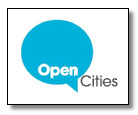In 1940 the French declared Paris an “open” city so the invading Nazi Army would not destroy it while capturing it. Today modern cities are starting to declare themselves “open” in slightly more trusting ways, by exposing their data and information to all citizens and, indeed, to anyone on the Internet. By declaring ourselves “open” we hope to marshal an army of citizens, developers and analysts to give us new insights into governing and better engagement with the people we serve.
I’ve had the opportunity to participate in a couple of fascinating conferences lately. One was the Open Cities conference sponsored by the Rockefeller Foundation in Washington DC. The other was “Future in Review”, Mark Anderson’s FiReGlobal conference held in mid-October, for the first time here in Seattle.
The theme is consistent: city governments, by opening their information, their data, their engagement processes, can generate a wealth of new ideas and understandings which make them more efficient and effective, and more robust, exciting places, with improved quality of life.
The old model, used for 250 years or more, is for a City is to collect as much data as possible about problems, its responses, services it provides and the general city environment. Then the typical city hires analysts or consultants – experts, if you will – to pore over the data and discern patterns. These experts then make recommendations for policy, action or changes.
Oh yes, we try not to forget regular citizens in this. We’ll present the experts’ ideas to citizens in public meetings for their “input”. And citizens can give feedback, one at a time, for two or three minutes each, in a public forum. A terrifying (or wonderful) example of this is a recent Seattle City Council budget hearing, 205 minutes of 2 and 3 minute mini-speeches, most focused on just one or two topics (cutback of Library hours) out of a $4 billion budget. If you have a spare three+ hours, watch it here.
Most such public hearings are very one-way – experts or city officials talking at people, citizens talking back individually to elected officials and experts. This is extraordinarily inefficient as dozens or hundreds of people “watch” the mini-speeches, while waiting their turn to speak. Far too much air time is taken up by one-issue, professional gadflies (“citizens in comfortable pants”), often with off-the-wall opinions not representative of most people. Almost as bad, often the only people with time or interest to show up are often homeowners and others who NIMBY (“not in my backyard”) the ideas, a negative dynamic. And this whole process is virtually the same as the process we used at the birth of the nation, in 1776, when our largest city was Philadelphia with 50,000 people.
Enter the Internet, and, more specifically, enter Web 2.0. All of a sudden, now in 21st Century America, there is tremendous computing power in the hands of ordinary people – smartphones, desktop and laptop computers. And those devices are connected, 24 hours a day, 7 days a week. Now you hear ordinary people talk about formerly obtuse technology concepts like databases and spreadsheets and pivot tables and Wi-Fi. And suddenly (at least in historic terms) there are millions of people and trillions of dollars involved in computing and software and development of applications.
In Seattle, for example, 84% of homes have access to the Internet. Nationally, there are 255 million cell phones , 21 million iPhones , and 101,000 iPhone applications . Cities are getting on the bandwagon. Many are publishing detailed crime statistics and even the details of 911 calls on their websites. You can find restaurant inspections and building permits and census statistics.
Public engagement, however, is still broken. We still hold public meetings with death-by-PowerPoint presentations and long lines of people trooping up to the microphone to give their 2 minute NIMBY mini-speeches.
Isn’t there a better way?
There are beginnings of better ways. Fedgov websites like Citizens Briefing Book and local sites like ideasforseattle allow some limited input online input from people – allowing people to post their ideas, view each others ideas, and rank them. More robust applications for engagement are emerging, from Seattle’s own Ideascale and companies like Athena Bridge. These applications allow people to shape ideas and develop them, commenting and ranking along the way.
But we need even more robustness – we need to bring such software to public meetings, so that, as officials or citizens are presenting ideas and talking, everyone in the room, or gee, anyone on the Internet watching the meeting, can be commenting, tweeting, and ranking, and the results are immediately displayed. The gadflies will quickly see their ideas have little public support.
In many other cases, obscure and even anonymous ideas and unique solutions to problems will emerge and be developed. Then, with open data feeds and citizen-developed applications, those solutions can be quickly tested against the real data published by a city which defines the problem. Almost as fast, options will emerge and consensus may develop on the right approach.
This new, emerging world of public engagement via the Internet and technology is not a panacea. It will take a lot of tweaking and mistakes before usable software emerges and public officials understand how to use it. And it won’t work in every case or to address every problem.
Yes, the hordes and armies of citizens are about to invade. So let’s declare our cities “open” and embrace them.
P.S. Those readers who are astute will make comments that Seattle is one of the major cities with no data.seattle.gov. Believe me, THAT will soon change!



